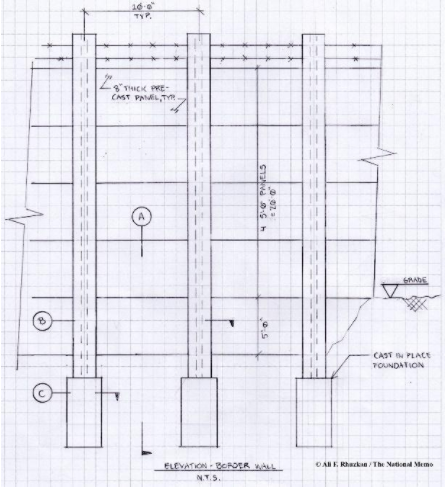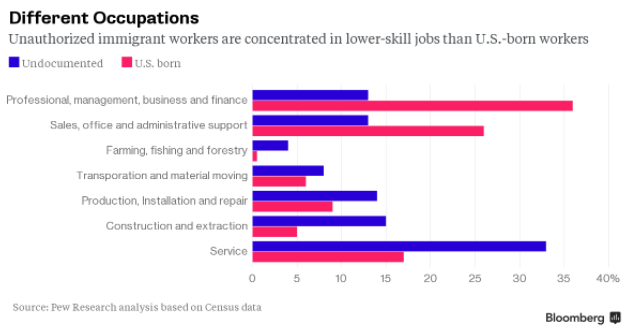This election has seen the deterioration of civil discourse and the proper exchange of ideas come to a boiling point. Statements issued by President Trump, Republicans, and Democrats have been shortened and maimed into brash statements that seem to only serve as a means for garnering attention. Trump is particularly guilty of this. A study by PolitiFact revealed that 75 percent of Trump’s statements turned out to be mostly or entirely false while the other 25 percent turned out to be half true or mostly true. This leaves us with a grand total of exactly zero fully true statements of all that were analyzed. The following analysis seeks to empirically illustrate the likely effects of various policies offered by Mr. Trump and his base.
The Wall
The construction of a wall along the Mexican border has been one of the most publicized and discussed policy proposals Trump has issued. The logistics of building this mammoth wall are far beyond anything Mr. Trump has ever attempted. Fortunately, structural engineer Ali F. Rhuzkan has done some work for us by doing research into the logistics of this proposal.
Some of the more striking observations that Mr. Rhuzkan makes are as follows:
“This wall would contain over three times the amount of concrete used to build the Hoover Dam.”
“Such a wall would be greater in volume than all six pyramids of the Giza Necropolis.”
“That quantity of concrete could pave a one-lane road from New York to Los Angeles, going the long way around the Earth.”
“We could melt down 4 of our Nimitz-class aircraft carriers and would probably be a few cruisers short of having enough steel.”
Rhuzkan’s wall model
I implore anyone reading this article to imagine all of the good that could be done with the money and materials that would go into making this wall. The funds could be used for programs to prevent the crime that Mr. Trump accuses undocumented immigrants of committing, shoring up our national debt, providing attorneys to refugees escaping violence, perhaps even for investing in foreign development to avoid the need for immigration in the first place.
Aside from the logistical and monetary realities of building this wall, it would tarnish our international reputation and harm our relationship with Mexico, a close regional ally. A wall between our two nations would send a message of indifference and hatred. It is hard for two cultures to learn from and respect one another through a barrier of cold steel and cement.
Another issue the wall creates is that it does not solve the underlying humanitarian issues surrounding immigration. The reality of the situation is much different than that which the political sphere has been discussing recently. Nowadays, immigration from Mexico has largely declined, with more Mexicans going back to Mexico than coming to the United States. However, a large portion of those coming to the United States are fleeing violence from Latin America and Mexico. These types of immigrants are not looking to sneak into the United States or steal jobs, but they are surrendering at the border. Many (roughly 38%) of these types of immigrants are women and children. No wall is going to stop these refugees from coming, and pretending they do not exist is not going to help their plight.
Deportation
Donald Trump has put his weight behind a deportation plan and, although he has backpedaled after his inauguration, the risk of him changing his mind further remains. Under Trump, 11 million undocumented immigrants could be deported. Among the reasons offered as justification are the costs to taxpayers, crime, and welfare abuse. More cynically, Trump has been quoted speaking to fellow Republicans saying that they should not pass comprehensive immigration reform simply because immigrants do not typically vote Republican.
Before moving into the issues with this plan, I would like to point out a contradiction regarding Trump’s reasoning for deporting immigrants. He has made broad statements claiming that immigrants come to America to take American jobs, but on the other hand claims that immigrants need to be stopped because they are abusing our welfare system. These two claims imply that immigrants are so hard working that they steal our jobs, but they are so lazy that they are feeding off our welfare system.
Aside from these issues with the deportation plan, like organizing a deportation force in the 21st Century to round up and forcibly remove 11 million human beings from this nation, there are significant economic consequences connected to this policy.
The sudden deportation of this many immigrants would leave a gaping labor shortage in our economy. The industries that immigrants work in are specific to immigrants (as shown in figure 2) and the loss of labor skills would leave certain industries bankrupt of labor with no one to fill the gap. Not every unemployed person in this nation is looking for any job, they will not settle for these low skill jobs.
The Washington Post illustrates a specific example of this labor shortage that would occur in California, Nevada, Texas, and New Jersey. The article states, “[E]ven if every unemployed American in those states took an undocumented worker’s job — wildly unlikely, given that most Americans are unwilling to do the dirty jobs filled by many immigrants — it would still leave hundreds of thousands jobs unfilled.” In California, undocumented workers range anywhere from a third to half of the agricultural workforce. Deporting these immigrants would affect about half of the fruits and vegetables consumed in America and cripple California’s farming industry.
Deporting 11 million immigrants would provoke massive international displacement. Dictators and extremists cause humanitarian exoduses, not those with democratic principles.
Regardless, all of this fear mongering over immigrants is in vain. On top of the evidence already presented, plenty of other studies have shown the benefits of immigration for host countries. I sifted through examples from Miami to Great Britain, but I settled on a scenario from South Africa published in Foreign Policy magazine to illustrate my point.
Before the end of apartheid in the early 1990s, black South Africans had their citizenship revoked and were exiled to quasi-nation states called Bantustans, cut off from white South African society. Before apartheid fell, white South Africans were afraid, as many in America are today, of what would happen when the barriers fell and the black South African population (9 times that of the white population) flooded the labor market. To put this into perspective, this would be the same proportion as the entire population of Brazil, China, and India simultaneously immigrating to the United States. The result was unlike anything anyone expected. Household incomes for both black and white South Africans doubled between 1993 and 1994. This type of economic situation has repeated itself as well. When the EU lowered labor migration restrictions between European countries Portuguese immigrants rushed to Denmark for work. This left both Denmark and Portugal with a more than 2% GDP increase rather than economic collapse.
The above examples illustrate that immigrants are complementary workers to native populations. They get more work done faster, and they do not simply come and take jobs. They create more. More jobs and more wealth. This is a statistic that Donald Trump should look into. Instead of building a wall to block out immigrants and silence their cries for help, we should be building bridges to help those in need and allow them to contribute to our economy. Instead of deporting 11 million immigrants, we should be granting them a path to citizenship so they can continue to contribute to our economy and be allowed to pay taxes.
Conclusion
The Mexican border wall and broad deportation plan are the extreme end of President Trump’s policy statements on immigration. His administration has backpedaled from some of these claims, but the possibility of a partial implementation, or reversal of policy remains. My hope is that the aforementioned policy proposals have been placed in sufficiently clear light regarding their actual effects on the U.S. population and economy.

